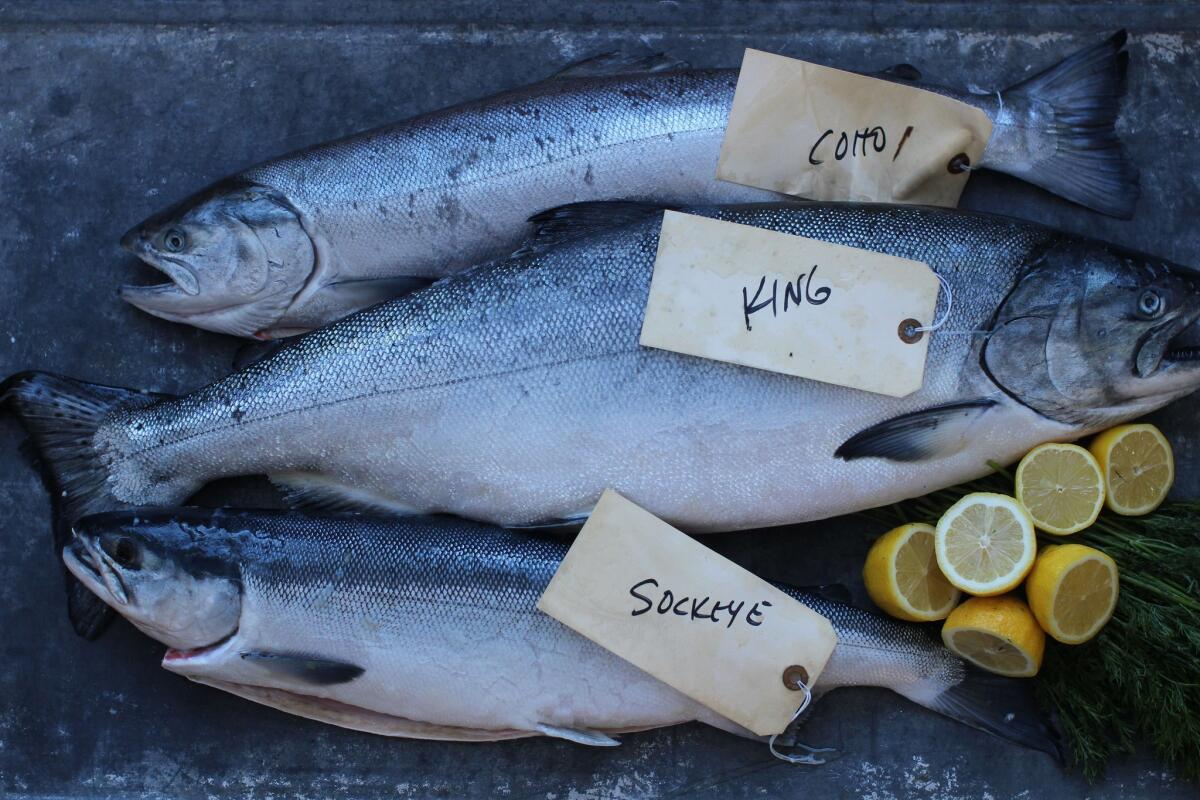Monterey Bay Aquarium Seafood Watch turns 15

Wild-caught salmon is generally a “Best Choice” or “Good Alternative,” according to the Seafood Watch.
- Share via
In 1997, the Monterey Bay Aquarium put on an exhibit about sustainability titled “Fishing for Solutions.” As part of the program, the aquarium restaurant featured table cards that listed which fish diners should seek out and which they should avoid. Soon, the staff started noticing those little pieces of paper were disappearing at a rapid rate.
That’s how the idea for the Seafood Watch program was born, officially launching in 1999. Fifteen years later, more than 52 million of those wallet-sized cards have been printed, now in six different regional editions. A smartphone app was introduced in 2009 that has been downloaded more than 1 million times.
But Seafood Watch is much more than a token that allows consumers to make smarter choices. It is also affecting global fishing decisions.
“No one wants to be on our Avoid list,” says Jennifer Dianto Kemmerly, director of the Seafood Watch program. “So we are seeing behaviors changing. It used to be that quality, price and consistency were the things companies cared about when they were sourcing seafood. Now there’s another purchasing spec — sustainability.
“That’s how I know Seafood Watch has moved beyond being a trend into something more — it’s an expectation of a norm.”
Seafood Watch uses a team of fisheries scientists to examine more than 350 commonly bought fish and shellfish. Each is analyzed not only for the health of the species population, but also for how the fishery affects other species, how well it is managed and how the fishery affects the habitat and ecosystem of the area in which it operates.
Farmed fish are rated on eight criteria, including what and how many chemicals are used, what they are fed and how many escape. In the near future, human concerns such as labor practices will be added.
Each fish is then rated either Best Choice, Good Alternative or Avoid. For those who want to dig a little deeper, simple explanations are offered for how those decisions are made. And if you want to get really wonky, on the website you can download the 100-plus-page full research reports.
Fish are reviewed at least every three years, or whenever new scientific information is published. At any given time, Kemmerly says, there are 140 to 150 reviews in process, resulting in more than 70 status reports every year. These are pushed to the app almost immediately, though the printed cards may take a while to republish.
Ratings do change. For example, West Coast rockfish, which was to be avoided almost since the start of the program, was recently upgraded to Best Choice in many fisheries as a result of rebounding populations due to improved management practices.
Seafood sustainability is a devilishly complex topic, and that is reflected in the Seafood Watch decisions, which sometimes might be frustrating to those looking for simple answers.
Chilean seabass, for example, can be either a Best Choice or an Avoid depending on where and how the fish is caught. Fished longline off the Heard and McDonald Islands off of Australia, Falkland Islands off Argentina and MacQuarie Island south of New Zealand and it’s a Best Choice.
Fished the same way off the Crozet, Prince Edward and Marion Islands off of South Africa or off of Chile, and it’s a problem because of concerns about overfishing and bycatch (the accidental catching of unintended fish) in those areas.
Kemmerly says the success of Seafood Watch isn’t because every shopper in America has started carrying a card in their back pocket. It’s more because the ones who do tend to be very noisy.
“We don’t need every consumer in the United States to show up and start asking questions about their seafood,” she says. “We just need enough of them to do that.
“When businesses start hearing these questions from their customers, they put pressure on their suppliers, who then go to the producers to make changes.
“That is success to me,” she says. “The market has spoken and the message is clear — you have to be sustainable.”
More to Read
Eat your way across L.A.
Get our weekly Tasting Notes newsletter for reviews, news and more.
You may occasionally receive promotional content from the Los Angeles Times.











